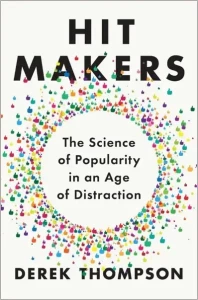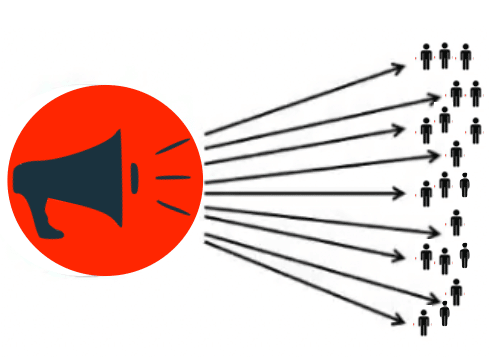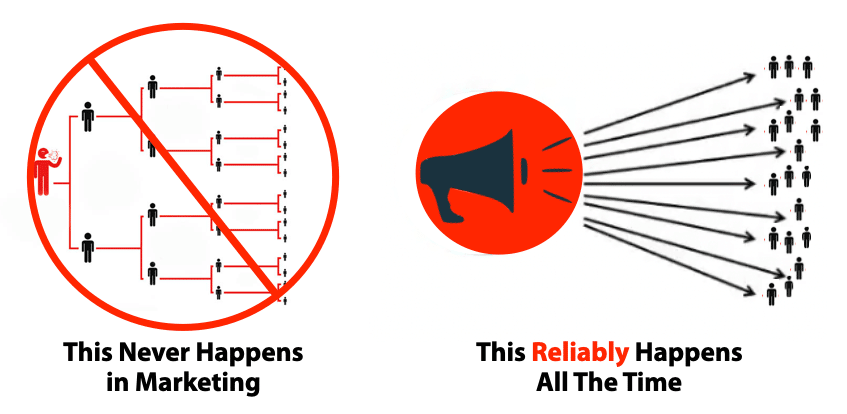The Internet Study that Shows “Viral” Spread to be a Myth
Almost nothing “goes viral” except viruses.
This isn’t opinion, it’s the result of an internet study of “a billion diffusion events on Twitter, including the propagation of news stories, videos, images, and petitions.”
What the study expected to find was true viral spread (aka, “structural virality”) wherein each twitter user spread the content to more than one new user, who in turn then spread it on to others, and so on.
That kind of virality requires a repeated, ongoing, and multiplicative spread, as visualized in the chart below:

 Yet the study failed to find a single instance where that happened.
Yet the study failed to find a single instance where that happened.
To quote Derek Thompson, who popularized this study in his book, Hit Makers:
“More than 90 percent of the messages didn’t diffuse at all. A tiny percentage, about 1 percent, was shared more than seven times. But nothing really went fully viral — not even the most popular and shared messages. The vast majority of the news that people see on Twitter — around 95 percent — comes directly from its original source or from one degree of separation.”
Instead, the researchers found that [formatting and bolding mine]:
“…popular events regularly grow via both broadcast and viral mechanisms, as well as essentially all conceivable combinations of the two.
Nevertheless, we find that structural virality is typically low, and remains so independent of size, suggesting that popularity is largely driven by the size of the largest broadcast.”
In other words, in every instance of reputed “viral” popularity, the researchers found a pattern dominated and determined by broadcast diffusion, often taking the form of “Dark Broadcasting.”
Dark Broadcasting as the REAL cause of “viral” spread
“Dark Broadcasting” happens when online influencers with larger audiences or networks spread or recommend a product out to their followers, unbeknownst to the beneficiary.
Essentially, dark broadcasting is just broadcast diffusion that happens under the radar.
Nobody scratches their head on how something took off if it was prominently featured in the New York Times or recommended by, say, Ellen or Oprah or Jimmy Fallon.
But business owners will wonder what happened if an online influencer that they don’t know about plugs their product or service, which is when the myth of “going viral” is invoked as an explanation.
That means that the spreading of content is almost always one to many, and looks like this:

“Hit Makers” Have Always Known Broadcast Diffusion Was the Sole Path to Success
The dynamic of dark broadcasting / broadcast diffusion matches the experiences of pop-music hit makers.
This is why Payola remains such a huge part of the radio and music business.
Basically, without some form of broadcast reach, a song will not and cannot make it from word of mouth alone.
So bribing stations, streaming services, influencers and tastemakers remains an absolute must in the industry.
Applying This to Your Business
If you’ve been relying on traditional Word-of-Mouth or “viral marketing” to drive growth for your business, you should update your marketing strategy to fully leverage broadcast media.
While I believe in the power of recommendations and referrals (having written a book on how to optimize that), I’m also well aware of their limitations.
And the limitations — as discussed above — are the bad news for those relying on WOM or viral marketing as the primary means for growth.
The good news is that most of the things smart business owners do to optimize for Word-of-Mouth translate wonderfully to broadcast ad campaigns.
So by all means, keep:
- Creating and delivering remarkable products and services
- Enhancing word-of-mouth through storytelling
- Leveraging user-generated content/reviews
But not because those things will drive explosive growth on their own.
Do it because those things will fuel your success when you leverage Broadcast Diffusion to achieve the explosive growth you are really looking for.
There’s a reason that radio and TV ads still work shockingly well, despite the internet declaring their death every year for the past twenty years.
And there’s a reason why even blockbuster movies budget as much to promote the film as to make it — they know better than to rely on WoM or “viral spread.”
The reason is because broadcast diffusion creates fame in a world where Word-of-Mouth and internet advertising do not.
So as you set your marketing budget for 2023, remember to invest 60% for broadcast-based brand building.
And while you’re at it, hire a branding consultant to ensure you get the maximum performance from your broadcast ads as possible.
- Getting a Foot in the Door — Of Perception - November 27, 2025
- What Digital Superstars Know About Offline Advertising - November 17, 2025
- Unmistakable: A Tale of Two Boots and Branding Done Right - November 8, 2025

